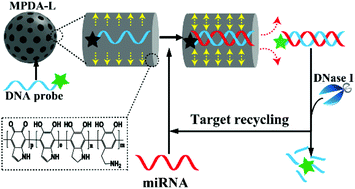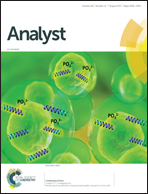Fluorescent miRNA analysis enhanced by mesopore effects of polydopamine nanoquenchers†
Abstract
The combination of fluorophore-labelled single-strand DNA probes and nanomaterial quenchers has shown great potential in miRNA detection. The development of advanced detection systems by understanding and controlling the fluorescence quenching/recovery via nanoquenchers’ microstructures and local morphologies is an attractive area warranting further investigations. Inspired by nanopore sequencing, we present a novel miRNA sensing strategy using fluorophore-labeled DNA as probes and a type of large-pore-sized mesoporous polydopamine nanoparticles (MPDA-L, 70 nm in diameter) as fluorescence quenchers. It is revealed that the quenching efficiency of MPDA-L towards the fluorophore labelled on the probe, reached more than 99% at a relatively low particle concentration. Moreover, the mesopores effectively protected the probe DNA from cleavage by DNase I which was used for signal amplification. Sensitive detection of miRNA with a low detection limit of 32–40 pM, as well as a linear detection range of up to 5 nM, was realized by the mesopore effects via a greatly improved differential affinity of ssDNA and the probe–miRNA heteroduplex toward the surface of nanoquenchers. Interestingly, enhanced DLVO (Derjaguin–Landau–Verwey–Overbeek) repulsion generated inside the pore surface by the negative surface–curvature effect correlates with the improved duplex detachment and fluorescence recovery. The developed strategy can be successfully applied to quantify down-regulated let-7a and up-regulated miRNA-21 in different types of cancer cells by using total RNA samples from cell lysate. These findings are expected to inspire strategies and pave a way for utilizing porous nanomaterials for constructing miRNA detection systems.



 Please wait while we load your content...
Please wait while we load your content...